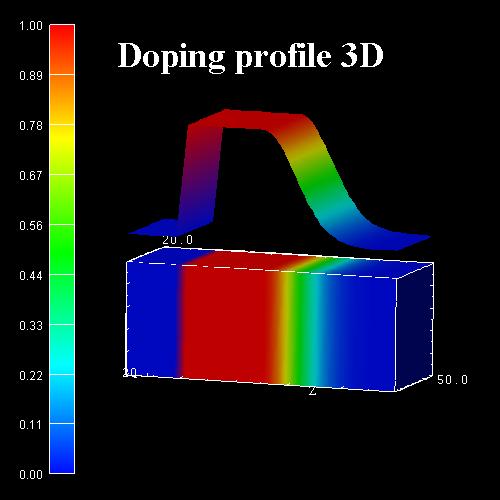|
Up
| | This is the old documentation.
Here's the link to the new documentation.
generation{}
Specifications that define information on generation rate.
The generation rate profile is assiged to a certain region.
It can be printed out
using the keyword
structure{ output_generation{} }.
structure{
...
output_generation{
# output generation rate for each grid point in units of [10^18/(cm3
s)]
boxes = yes/no
# (optional)
}
region{
...
generation{
constant{
rate =
1.0e18
# generation rate [1/cm3s] (applies to 1D, 2D and 3D)
add =
yes
# yes or no
(default = yes)
}
linear{
rate =
[1e18,2e18]
# [1/cm3s]
x
= [50.0,100.0]
# x
coordinates of start and end point [nm]
y
= [50.0,100.0]
# y coordinates of start and end point [nm] (2D
or 3D only)
z
= [50.0,100.0]
# [nm] (3D only)
# This defines a generation
rate
profile, which varies linearly along the line from the point (50,50,50)
to the point (100,100,100)
#
and stays constant in the perpendicular planes.
add =
yes
# yes or no
(default = yes)
}
gaussian1D{
#
rate =
1.0e18
# [1/cm3s]
dose
= 1e12
# dose of implant [cm-2] (integrated density of
gaussian function), typical ranges are
from 1e11 to
1e16.
#
rate or dose has to be specified, but not both
simultaneously.
# rate = dose / ( SQRT(2*pi) * sigma_x )
x
= 50.0
#
sigma_x
=
5.0
# root mean square deviation in x direction (statistical fluctuation of Rp)
[nm]
y
= ... #
sigma_y =
...
#
z
= ... #
sigma_z =
...
#
# Only
one out of x, y, z and the appropriate standard deviation (sigma) has to be
specified.
add =
yes
# yes or no
(default = yes)
}
This profile corresponds to LSS theory (Lindhard, Scharff, Schiott
theory) for doping - Gaussian distribution of ion implantation.
gaussian2D{
#
rate
=
1.0e18
# [1/cm3s]
dose
= 1.0
# dose of implant [cm-1] (integrated density of
2D gaussian function)
#
rate or dose has to be specified, but not both
simultaneously.
x
= 50.0
#
sigma_x
=
5.0
# root mean square deviation in x direction [nm]
y
= 50.0
#
sigma_y =
5.0 #
z
= ... #
sigma_z =
...
#
# Exactly two out of x, y, z
and the appropriate standard deviations (sigma) have to be specified.
add =
yes
# yes or no
(default = yes)
}
gaussian3D{
#
rate
=
1.0e18
# [1/cm3s]
dose
= 1.0
# dose of implant [dimensionless] (integrated density of 3D
gaussian function)
x
= 50.0
#
sigma_x
=
5.0
# root mean square deviation in x direction [nm]
y
= 50.0
#
sigma_y =
5.0 #
z
= 50.0
#
sigma_z =
5.0 #
# All three
x, y, z and the appropriate standard deviations (sigma) have to be specified.
add =
yes
# yes or no
(default = yes)
}
import{ #
import generation profile from external file.
import_from =
"import_generation_profile"
#
import{}.
The file being imported must have exactly one data component.
}
} # generation
} # region
} # structure
It is also possible to remove a generation rate from a specific region.
structure{
region{
generation{
remove{} }
# remove generation rate from this region, to keep certain regions free from
generation rate.
} # region
} # structure
Examples (3D)
generation{
gaussian3D{
# three-dimensional Gaussian profile
rate =
10.0e18
# [1/cm3s]
x = 30
y = 20
z = 20 # position of the Gauss center
(x,y,z)=(30,20,20)
sigma_x = 5 sigma_y
= 2 sigma_z =
5 # Gauss width along x, y and z directions
}
gaussian2D{
#
rate =
10.0e18
# [1/cm3s]
x = 10
y = 20
# position of the Gauss center
(x,y)=(10,20)
sigma_x = 5
sigma_y = 5
# Gauss width along x and y directions
}
}
- The following figure shows a 3D generation profile (although it says
incorrectly "Doping profile 3D" in the figure) that is defined inside a 20 nm
x 20 nm x 50 nm cube where the 50 nm are the z direction. The generation rate profile is
homogeneous with respect to the (x,y) plane, it only varies along the z
direction.

The generation rate profile is constant between z
= 10 nm and z = 25 nm with a rate of 1 x 1018
[1/cm3s].
It has Gaussian shape from z = 25 nm to z = 45 nm (gaussian1D). It is
zero between z = 0 nm and z = 10 nm, as well as
between z = 45 nm and z = 50 nm.
If you want to obtain the input file that was used to obtain this 3D
generation rate
profile plot (constant + Gaussian shape), please contact
stefan.birner@nextnano.de.
-> 3Dgeneration_profile.in
doping{} and
generation{} is always additive per default
(add =
yes) (unless
import is different),
i.e. each profile adds to the already existing dopants/fixed charges/generation at a given point.
At the same time, using remove{}, all species of the already existing doping or generation concentrations can be removed.
However,
there is also the problem that remove{} removes all species of dopants/fixed charges at a given point.
Thus, removing e.g. only donors but not acceptors is difficult.
This problem is solved by the new "add = yes/no"
flag, which the user can specify for each profile (and thus for the species of that profile),
whether the profile should add to (which is the default) or
replace the already existing concentration of the profile species.
For
import{}, this flag has not been implemented yet.
|